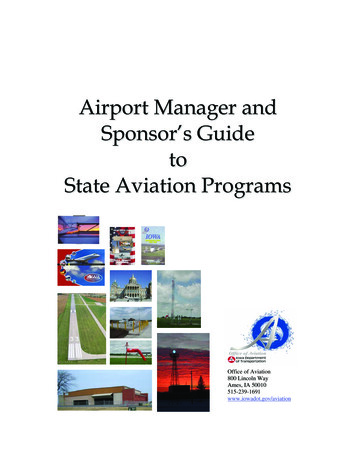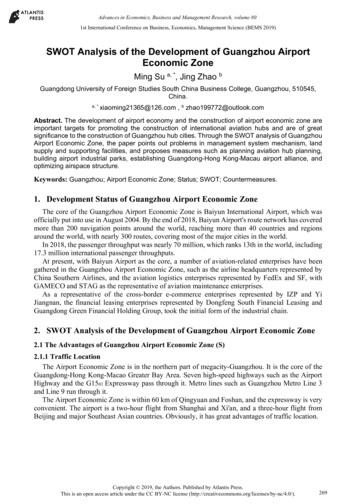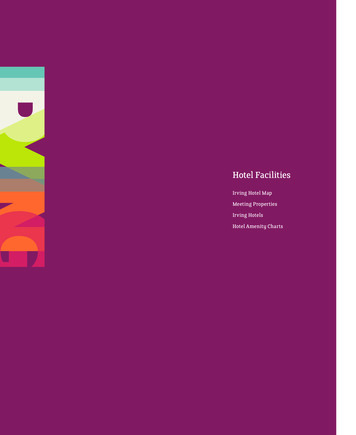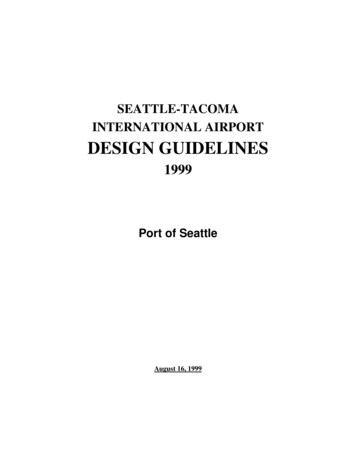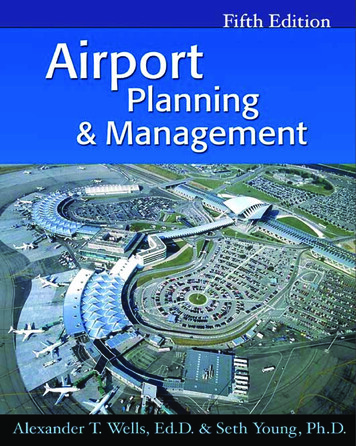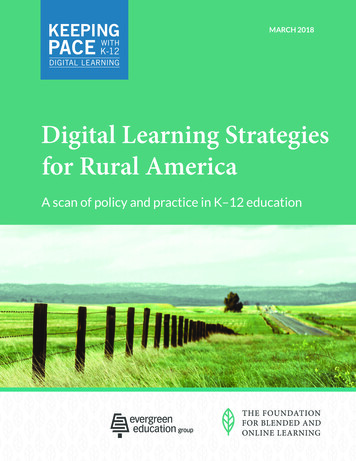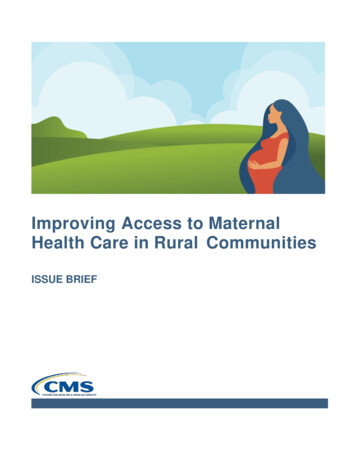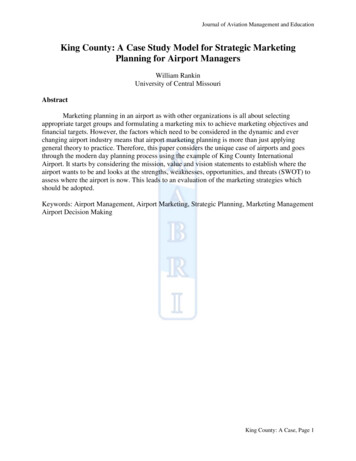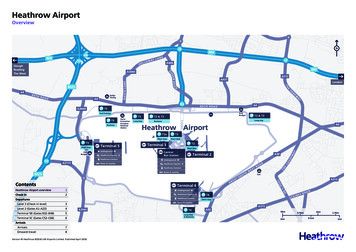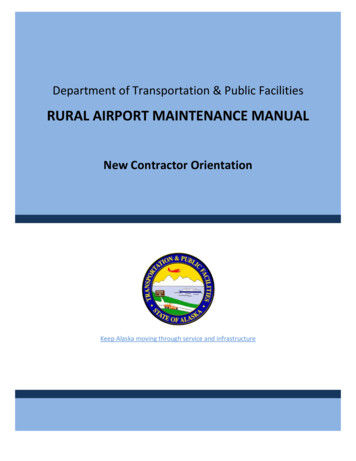
Transcription
Department of Transportation & Public FacilitiesRURAL AIRPORT MAINTENANCE MANUALNew Contractor OrientationKeep Alaska moving through service and infrastructure1
TABLE OF CONTENTS1. Introduction2. Contractor Responsibilities3. Safety and Security4. General Airport Knowledge5. Airfield Marking and Lighting6. Driving and Radio Communication7. Snow Removal Equipment Building (SREB)8. Equipment Maintenance9. Winter Airfield Maintenance10. Summary11. Employee Orientation Checklist12. Evaluation for Equipment Orientation13. Operators Daily Inspection Guide2
1. INTRODUCTIONRural Airports provide vital services to our Alaskan communities such as: Connecting the local people with the rest of Alaska and the world. Supporting Medevac flights and transporting people to medicaltreatment facilities. Transporting goods and services which helps to support local businesses.As the State Airport Maintenance Contractor, your community will bedepending on you to keep the airport open and safe for use so that thesenecessary services remain available. This manual is intended to help youachieve these goals.Roles and ResponsibilitiesIt takes many people to keep our airports safe and listed below are key playersto ensure this happens. Federal Government – The Federal Aviation Administration (FAA)publishes laws known as Federal Aviation Regulations (FAR’s). Thesemust be followed to stay in compliance. State of Alaska (SOA) – Alaska Department of Transportation (AKDOT)plans, builds and supports the maintenance of village airports. The statealso has guidelines that must be followed.3
Rural Villages – A resident of the village steps up to perform the day today maintenance and operations at the airport under contract withAKDOT. Air Carriers – They provide safe and reliable service into yourcommunities. They often provide feedback to AKDOT on the airportfacilities and services. AKDOT – In the back of this manual there are some helpful names andnumbers when you have questions, need help, or need something fixed.2. CONTRACTOR RESPONSIBILITIESAs a contractor, you have the very important responsibility to make sure theairport is safe and secure. No two airports are identical, but there are a variety ofduties common to all airports. You must perform these duties in a professionalmanner: Never work under the influence of drugs or alcohol and be aware that anillness may affect your work performance and safety. Communicate with pilots using “Air to Ground” or “VHF” radios. Perform basic maintenance activities. Operate equipment properly. Keep the inside of buildings clean and safe. Help initiate Notices To Airmen (NOTAMs) as required. Perform snow removal activities when necessary. Protect and care for the tools and equipment. Perform routine maintenance on equipment, i.e. oil, greasing, belt and hosereplacements. Basic runway light and windsock inspections. Responding to emergencies such as fuel spills and aircraft accidents.4
Consequences Of Poor MaintenancePoor maintenance of the airport and its associated equipment can lead to thefollowing problems: Airplanes can crash and people can die. Equipment and property can be damaged or rendered un-usable. Food and other essential goods that people rely on may not be able to arrivein your community. People cannot travel to receive medical services, attend meetings andsporting events, or go on vacations. Mail services may be interrupted. Airlines may be restricted to serve your community.NOTAMS“Notices To Airmen” (NOTAMs) are issued to let pilots know when the airport isnot up to normal safety standards or something is out of the ordinary.NOTAMs are issued for a number of reasons such as: A runway is closed.Airfield lighting, navigational aids, and/or radios are inoperable.Temporary obstacles are near the airfield (i.e. cranes, containers).Flocks of birds are in the vicinity of the airfield.Notifications of runway, taxiway, and apron status in respect to snow, ice,and standing water. Notifications of frost heaves, potholes, depressions, and soft spots.5
When conditions such as these exist, it is your responsibility to issue a NOTAMand to keep it current. Also, contact your supervisor with this information so theyare aware of the current conditions.3. SAFETY AND SECURITYAs a contractor for the State of Alaska you are expected to include SAFETY intoeverything you do at the airport. YOU MUST: Keep the airport safe Keep the people safe Keep yourself safeTo accomplish these very important goals, ALL of your work must be done in asafe manner.Security is another important responsibility for you as the contractor. Keepingthe State's equipment safe and secure is vital for you to do your job safely andefficiently. You must always remember to: Keep the buildings, fuel tanks, and equipment locked when not in use. Prevent or report when cargo, fuel barrels, vehicles, or any other materialare stored on the apron, taxiways, and especially the runways. These areasmust remain clear for safe passage of the aircraft. Report vandalism and security infractions immediately to local lawenforcement and AKDOT.People on the RunwayThe runway is not a safe place for people or vehicles, especially snow machinesand ATV’s. You are expected to ask unauthorized people to leave the restrictedareas (runways and taxiways) and to remove their vehicles immediately. If theyrefuse to do so, again, call the local law enforcement and AKDOT.6
Aircraft AccidentsIf an aircraft has an incident or accident near your airport, you can use Stateequipment and buildings to help your community respond to the event. As theState contractor we ask you to do the following: Call your local law enforcement and ask for assistance if necessary. Call your supervisor and let them know what has happened. When possible, take as many pictures as you can. This can be done withphones, digital cameras, film cameras, and even from other people at thescene. Pictures are a critical part in the investigation.Personal AccidentsIf you are injured while working, you must: Call for help immediately if required Seek first aid or medical attention Notify your supervisorVehicle / Equipment AccidentsVehicles and equipment do have accidents at airports and here are someexamples of them: Hitting the doors of the building with a loader, grader, or dozerBacking too far into the building and hitting the wallTrucks hitting the outside of the buildingSnow machines or ATV’s crashing on the runways, taxiways, or aprons.If any of these accidents or a similar accident happens at your airport, call yoursupervisor as soon as possible. If there are any injuries involved in theseaccidents, always call your local law enforcement first. This will insure thatmedical assistance will arrive as quickly as possible.7
Fuel SpillsIf you encounter a fuel spill, the first step is to try to stop the flow if possible. Thenext step is to try and contain the spill so it will not reach any drains orwaterways. Less than 5 gallons may be contained and cleaned up locally and you maycall your supervisor for help or materials. More than 5 gallons MUST be reported to you supervisor. Additional training may be required for these types of incidents.4. GENERAL AIRPORT KNOWLEDGEAirport TerminologyMost of the following terms are used throughout the world, so they shouldalways have the same meaning for everyone.RunwaysThe surface where aircraft land and take off from and are numbered according tothe direction they face based on a compass heading.ApronThese are the areas where the aircraft park and load or unload passengers andfreight.8
TaxiwaysThese are the areas that join the runways to the apron and are identified byletters. They are referred to with the phonetic alphabet(i.e. A Alpha, B Bravo, C Charlie ).Threshold AreasGenerally, this is the first one or two hundred feet of each end of the runway.Over-runsThese are the developed areas just before each end of the runway. You mustkeep these areas in the same good condition as the runway itself in case of anaircraft landing short or overshooting a runway.Safety AreasThese are areas along the edges of the runways. These areas go beyond therunway edge lights, should be clear of obstacles, and should be firm enough tosupport an aircraft.Common Traffic Advisory Frequency (CTAF)This is the radio frequency for your airport. Pilots use this frequency when takingoff from, landing at, or in the flight pattern at your airport. You, as the contractor,can communicate with the pilots on this frequency to inform them of runwayconditions or any other important information that they may need to know. Thisfrequency may also control the runway lights at your airport.9
WindsockThis is an orange fabric cone at the end of a pole that blows like a flag. It showsthe pilots which way the wind is blowing and how strong it is blowing at groundlevel. They need to be changed out when the color fades, they get damaged, orthey simply get blown away. It is also the contractor’s responsibility to grease thepole two (2) times a year. Most airports have several windsocks in the area.Airport BeaconThis is a green and white rotating light that signals pilots where the airport islocated and what type of airport it is. If this light burns out, the contractor mustreplace the bulb.5. AIRFIELD MARKING AND LIGHTINGAirports are standardized in reference to the color of lights and markings they useon the runways and taxiways. This helps the pilots know where they are on theairfield as well as where to taxi.RunwaysWhite lights and white paint are used to mark the runway edges. There are onlypaint markings if the surface is paved. Towards the ends of the runways, thelights may be split to show white in one direction and amber in the other direction(split lens light). The amber color is used to show a pilot that they are nearing theend of a runway. On the threshold of the runway, there will be a red and greensplit lens light located to show the pilot where the beginning and the end of therunway is. (see figure 1)10
TaxiwaysTaxiways are marked with blue lights and yellow paint markings. There are onlypaint markings if the surface is paved.Apron/RampRural airports generally do not have Apron/Ramp lights.Airfield Lighting RepairWhen light bulbs burn out, you are expected to replace them. When you areawarded the maintenance contract, you should have some training on how toperform this task safely. You should avoid hitting or damaging airport lightingwhile performing maintenance. It will be your responsibility to repair minordamage done to airfield lighting such as broken couplers, lenses, and stems. Partsfor fixing the lights can be ordered by calling your supervisor or the electrician.If your airport is equipped with cones, they should be predominantly orange withreflective bands. Damaged or faded cones should be replaced. Call yoursupervisor to order new ones.Signs and threshold markers must remain visible and free of damage. Keep snow,brush, and any other items away from the signs and threshold markers. Call yoursupervisor if any of these things are damaged.11
figure 112
6. DRIVING ON THE AIRFIELD AND RADIO COMMUNICATIONAircraft always have the right-of-way. You should never interfere with anaircraft's intended path unless that path is un-safe. If it is un-safe, you areexpected to communicate with the pilot using a radio.Your equipment will have a two-way radio (ground to air). This enables you totalk with the aircraft that are in the area. The Common Traffic AdvisoryFrequency (CTAF) is the frequency you will need to tune your radio to so you cantalk to the pilots. Depending on what area you are in is what determines whatfrequency you tune to. The aircraft use CTAF to talk to other planes in the areaand to talk to you on the ground. When talking on the radio, always say who youare calling 1st and who you are 2nd.Example: “ERA 27M, this is Akiak Maintenance”.Pilots will announce on CTAF when they are coming to your airport. When theydo call, they will report their position. These positions are shown below.Knowing these positions can help you find the plane as it gets near your airport.13
7. SNOW REMOVAL EQUIPMENT BUILDING (SREB)These buildings are built by AKDOT to house and protect state equipment at yourairport. When the equipment is not being used, it should be locked inside thebuildings. Parts and tools for working on the equipment or maintaining thebuilding can also be stored inside. You should keep the inside of the buildingneat, clean, and not cluttered with items that do not belong to the state.For example: No private snowmachines or ATV’s No outboard motors or skiffsIt is very important that you keep everything locked up when you are not at theairport. This includes: Lock the main doors. Lock the equipment doors. Lock the fuel tanks and/or the gates to the fuel tanks. Lock the lighting and radio building.Equipment DamageUse caution when driving equipment into and out of the buildings. It is verydifficult to repair the buildings once they have been significantly damaged. Theseare some of the common accidents: Hitting the equipment doors. Hitting the building with the wing blade. Backing into the back wall of the building.Fuel TanksAs a contractor for the State of Alaska, you are expected to protect the fuelsupply provided for your equipment and buildings.14
THE USE OF STATE FUEL FOR ANYTHING OTHER THAN STATE EQUIPMENT ORSTATE BUILDINGS IS A CRIMINAL ACT!This means: Make sure the fuel is locked up. Make sure the fuel is protected from the weather.Fuel tanks should not be left with pumps removed or openings that would allowwater to get into the fuel.VandalismReport any vandalism to AKDOT, local law enforcement, the Alaska State Troopersand your supervisor as soon as you notice the damage. Common things to lookfor are graffiti/spray paint, broken windows, and bullet holes.8. EQUIPMENT MAINTENANCEAs an operator, you will be required to perform some basic maintenance tasks.This includes things like adding motor oil, changing a tire, greasing the equipment,or changing a cutting edge.Equipment Walk-AroundsAs a daily routine, you must do a walk-around inspection on the piece ofequipment you are about to operate. You will be looking for: Leaks or puddles of motor oil, hydraulic fluid, anti-freeze, and diesel fuel.Loose nuts and bolts.Unusual signs of wear.Low or flat tires.15
Low fluid levels (engine oil, hydraulic fluid, transmission fluid, coolant, andfuel). Cutting edges on mold boards, plows, and buckets. Cleanliness of the windows, lights, and the cab area.Do not let the cutting edges on graders, buckets, or plows get too low. Whenthey are down to 1” or less they should be changed to prevent permanentdamage to the mold board, plow, or bucket.If you notice anything wrong during the walk-around that you cannot fix yourself,contact your supervisor or mechanic.You are required to report the equipment hours to your supervisor at the end ofeach month. This lets the mechanics know when the service is due on each pieceof equipment.Pre-Winter InspectionDuring the summer months, you should check to make sure your equipment isready for the next winter. Here is a list of things to look for: Block heaters are working properly.Batteries are in good condition (charged and terminals in good shape).Anti-freeze at correct strength.Winter oils, lubricants, and fluids are installed.Cab heaters operational.Windshield wiper blades are working and in good condition.Tires are in good condition.Cutting edges, impeller blades and chutes are in good repair.Fuel tanks are checked and free of moisture. You are also required to keeptrack of your fuel consumption and report this to your supervisor at the endof every month. This helps them order fuel in advance so you will not runout.16
*IMPORTANT* Please call your supervisor or mechanic as soon as possible ifthere is a problem that you cannot fix.9. WINTER AIRFIELD MAINTENANCEThe key winter maintenance activities are snow removal and ice control.Winter Airport Safety NOTAMS – You must issue a NOTAM if more than 2” of snow is on therunway, if there are berms present, or if you are going to be on therunway plowing snow. Contact your supervisor if you are unable to plow the snow or if thereare berms you cannot remove. They will assist you as soon as they areable. Use your radio to communicate with pilots and answer any questionsthey may have. Snowplowing – Try to keep your blade 1” above the gravel surface.Getting too low causes the gravel to be bladed off the runway creatingmore work and money to fix. Snow Berms and Windrows – Remove snow berms and windrows asquickly as possible. Do not leave them on the runway edges, ends ofrunways, or across the entrance to a taxi-way.17
Airport InspectionsDuring the winter, it is very important to check your runway conditions duringand after snowfall events or during times of high winds. The wind may leavesnow drifts on the runway which can be just as dangerous as deep snow.Snow Removal PrioritiesYou should inspect the runway to make sure the snow or drifts are no deeperthan 2” (two inches). You also need to check that aircraft do not have to taxithrough any snow berms. Snow berms on the sides of runways or taxiwayscannot be any higher than 12” (twelve inches) high and they should be pushedoutside of the lights as soon as possible. High snow berms can cause seriousdamage to an aircraft if they run into one.There are three levels of snow removal priorities:1. Runways2. Taxiways3. Ramps/ApronsSnow Plowing Tips Leave 1” (one inch) of snow on the runway. Do not plow the gravel off therunway. Maintain the crown on the runway as best as possible.(see figure 2) Do not plow the snow onto the runway or taxiway lights. Leave the windrows or berms 5’ (five feet) inside the lights. As soon aspossible, these berms should be carefully pushed outside of the lights18
without damaging any lights. Push this berm as far off the shoulder aspossible. This gives you more room for snow later in the season and it willhelp with break-up in spring. The longer you wait, the harder the bermsbecome making them much harder to move. Do not leave snow berms across any taxiways or the ends of the runwaysbecause this may cause damage to aircraft.Snow RemovalPlowing the runway is the first priority and there are two acceptable methods forremoving snow.1. Split the Runway – This is the fastest, safest, and preferred method forremoving the snow on the runway. Plowing lengthwise, you start in themiddle of the runway and move the snow to the right towards the edgelights. (see figure 3) (Plowing to the right is helpful because many of thegraders have a wing blade on the right side allowing you to make use of thisattachment). Once you reach the end of the runway, lift your blade andturn around. Still plowing to the right, proceed down the opposite side ofthe centerline moving the snow towards the edge lights. Continue doingcircles moving the snow from the center of the runway to the edges of therunway.Use this method when there is little or no wind or if the wind is strong butblowing down the length of the runway. Leave your windrows/berms 5’(five feet) inside of the edge lights. You can now carefully push this bermoutside the lights and off the edge of the runway as soon as possible.Remember to be careful not to damage any of the runway or taxiway lights.2. Plow across the runway – This method can be used when there is astrong crosswind. Starting at one edge of the runway and plowinglengthwise, begin moving the snow across the entire width of the runway.Plow in the direction the wind is blowing so it helps you and not hurts you.Your first pass should be 5’ (five feet) inside the lights to avoid damagingthem. You must also be careful with the threshold lights or cones when youare turning around. Once you reach the end of the runway lift your blade,19
turn around, and change the direction of your blade to the opposite side(see figure 4) (If you were plowing to the right, rotate your blade so you areplowing to the left for the next pass down the runway).This technique makes the runway unsafe and unusable until you arefinished plowing the runway. This is because you are moving the bermacross the entire width of the runway. This technique also creates a muchlarger berm so clearing it off the runway as soon as possible is crucial. Ifyou have a berm on the edge of the runway and a pilot wants to land, youmust let them know the location and the height of the berm.20
Figure 221
Figure 322
Figure 423
10. SUMMARYAs you can see, obtaining a state contract for airport maintenance comes withmany rewards and responsibilities. Many people rely on you to do a safe andaccurate job maintaining the airport in your community. If you feel thatsomething is unsafe or if you are having problems with your equipment, neverhesitate to call your supervisor. Using this manual as a training and a referenceguide should make your job become easier, safer, and more efficient.24
EMPLOYEE ORIENTATION CHECKLISTEmployee:Supervisor:Does the employee understand:1.2.3.4.5.6.7.8.The contractor responsibilities?The importance of safety and security?The general airport knowledge?The airfield marking and lighting?Driving and communicating on the airfield?How to maintain the SREB?How to do basic equipment maintenance?How to do winter maintenance?Yes NoYes NoYes NoYes NoYes NoYes NoYes NoYes NoEmployee Signature:Date:Supervisors Signature:Date:25
EVALUATION FOR EQUIPMENT ORIENTATIONEquipment Type:Name:Date:It is very important to know and understand the equipment you are running.Please mark the level of understanding you feel you have received from thisorientation.Poor1Below Average2AverageAbove AverageExcellent3451. Walk around for entire machine2. Engine compartment (Engine oil, transmission fluid, hydraulic fluid,And coolant)3. Cab (Warning lights, gauges, switches, controls, steering and seatAdjustments)4. Attachments (attaching and removing buckets)5. Operator maintenance (what to lubricate, change cutting edges)6. Equipment limitations7. Safety (getting in and out of the equipment, seat belts, fireextinguisher)8. Were all your questions answered?9. Was the training worthwhile?Was there any information that was missed?26
OPERATORS DAILY INSPECTION GUIDEVEHICLE NUMBER MONTH/YEAR /ITEMS TO BE CHECKED DAILY:1.2.3.4.5.6.7.8.9.Clean Vehicle (Interior, Windows)Damage (Exterior, Interior, Missing Parts)Tires and Rims (Damage, Proper Inflation, Lugnuts are Tight)Fluid Leaks (Puddles under vehicle, fluids in engine compartment)Check Fluid Levels (Oil, Hydraulic, Transmission, Coolant, Fuel)Belts and Hoses (Check for fraying and cracks)Lights and Strobes (Make sure they are clean and functioning properly)Safety Devices (Seatbelts, Signs on vehicle)Instruments, Horn, Wipers10. Brakes and Steering (responsiveness and effectiveness)DateInitial the appropriate date once inspections are 5.6.16.26.7.17.27.8.18.28.9.19.29.10.20.30.27
28
Airport Beacon . This is a green and white rotating light that signals pilots where the airport is located and what type of airport it is. If this light burns out, the contractor must replace the bulb. 5. AIRFIELD MARKING AND LIGHTING. Airports are standardized in reference to the color of
